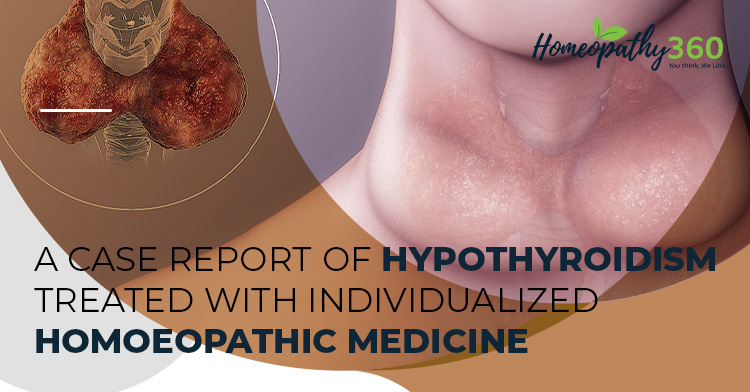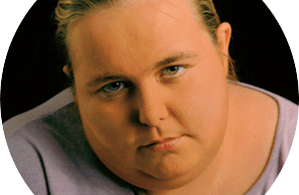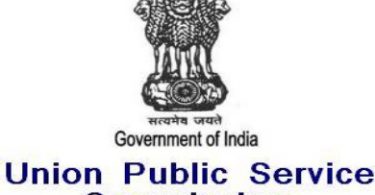
ABSTRACT:
Background: Being a very common disease of this era hypothyroidism patient have to face in our day-to-day clinic/OPDs everywhere. We are treating very successfully this kind of patients through individualised homoeopathy following the law and principles of homoeopathy. The following case report is one of them.
Materials and methods: This case report describes a 35 years old woman who suffered with hypothyroidism and came for homoeopathic treatment. In this case, we adopted Dr Kent’s method as the patient displayed characteristic mental as well as physical general symptoms. Through proper case taking we analysed and evaluate the case and select the medicine Pulsatilla nigricans 0/1-0/6 with taking help from Kent’s repertory.
Results: After taking medicine the patient gradually improved and after six months of treatment the patient’s blood report of TSH, T3, T4 found within normal limit as well as mentally and physically patient became healthy.
Conclusion: This case report showing the importance of case analysis and evaluation as an integral step after case taking and administration medicine maintaining the law principles of homoeopathy are the only way to cure the suffering of humanity. It also highlights the role of homeopathy in cases of endocrinal disorders without making any drug dependency and any adverse effect.
KEYWORDS: hypothyroidism, individualised homoeopathic medicine, pulsatilla nigricans, Dr. Kent’s method, case report.
ABBREVIATIONS: TSH: thyroid stimulating hormone, ICD: International classification of disease, LMP: last menstrual period, OPD- outdoor patient department, FT3 – free T3, FT4 – free T4.
INTRODUCTION: Hypothyroidism is a one of the most common diseases of modern days. At present, thyroid disease is the second most common endocrine disorder in India after diabetes mellitus.1 Common causes of hypothyroidism are iodine deficiency, autoimmune disease such as Hashimoto’s thyroiditis, surgical removal of the thyroid and radiation therapy etc.1 Symptoms of hypothyroidism include cold intolerance, weight gain, fatigue, infertility and menstrual abnormalities.2 The prevalence of primary hypothyroidism is 1:100 but increases to 5:100 if patients with subclinical hypothyroidism are included. It occurs more in females; the female, male ratio is approximately 6:1.1 The main line of treatment of allopathic system of medicine is to provide synthetic product of thyroid hormone for lifelong of the patient. Here, homoeopathy system of medicine makes a very good result in the patient suffering from hypothyroidism.
CASE REPORT:
A female hindu, married patient age 35 complaining of slight swelling of thyroid gland which is non tender, along with it the patient was suffering with menstrual irregularity of polymenorrhoea and cold intolerance, lethargy, etc. since about last 3 months.
History of present complaints:
In this case, the patient was previously treated by an allopathic physician for other illness. As per her doctor advice, she had blood reported and the doctor said that she was suffering from hypothyroidism. Knowing the drug dependency of modern system of medicine, the patient wishes to treat herself in homoeopathy and came to us. Since last 3 months patient was suffering from menstrual irregularities of early and profuse appearance of menses, chilliness, lethargy etc.
Past history:
Patient had a history of chicken pox at the age of 12 years. She also had history of tinea curis at the age of the age of 30 years which was treated with allopathic medication and ointment. And also, history of appendectomy at the age of 19 yrs.
Family history:
Family history revealed type-2 diabetes mellitus of her father and hypertension of her mother.
Gynaecological and obstetrical history:
Menstrual history revealed she have irregular, early menses of 15-20 days interval. Duration of menstruation of 5-6 days with profuse flow of blackish blood. Menarche at the age of 17 years. There were no concomitant symptoms before, during and after menses. The patient had no issue.
GENERALITIES OF THE PATIENT:
Physical general:
In her physical general she had desire for fried, spicy food, meat, sour but also intolerance of fatty food, milk causes dyspepsia. She had very less thirst of about 1 litre water taken daily. Sleep of the patient was sound but during sleep patient is preferring to high pillow under head. Patient was thermally chilly but preferred open air.
Mental generals:
The patient was mild, gentle. She was weeping easily. Prefer company.
CLINICAL FINDINGS:
General Examination
Pallor- mild
Blood pressure- 110/78 mmHg
Pulse rate – 76/minute
Respiratory rate – 18/minute
Local examination:
On examination of thyroid gland was slightly swelled up both sides symmetrically. Thyroid swelling visible without hyperextended neck. On palpation the surface was smooth, no tenderness present.
INVESTIGATIONS:
Thyroid profile test (TFT)
1. At baseline (20.03.2020) – FT3-0.87 ng/ml, FT4- 6,37 ug/dl, TSH-16.82 uIU/ml (Fig 2 A)
2. After treatment (27.11.2020) – FT3-1.11 ng/ml, FT4- 6.9ug/dl, TSH-3.57uIU/ml (Fig 2 C)
DIAGNOSIS:
This is a case of hypothyroidism, unspecified (ICD 10: IV, E03.9).3
Diagnosis was confirmed by symptomatology and TSH report; TSH report showed high value of 16.82µIU/ml.4
ANALYSIS AND EVALUATION OF SYMPTOMS:
Mental general symptoms:
- Patient was mild, gentle.
- Weeps easily.
- Prefer company.
Physical general symptoms:
- Desire for fried, spicy food, meat, sour.
- Intolerance of fatty food, milk.
- Patient was a chilly patient.
- Preferred open air.
- Delayed menarche.5
Particular symptoms:
- Slight swelling of thyroid gland.
- Polymenorrhoea.5
REPERTORIAL TOTALITY:
The following rubrics were selected for repertorisation from “Repertory of the homoeopathic materia medica” by Dr J.T. Kent6 as because the case presented with characteristics mental general, physical general and particular symptoms.7 [fig-1]
- MIND, MILDNESS
- MIND, WEEPING, tearful mood, etc.
- MIND, COMPANY, desire for
- STOMACH, DESIRE, fried food
- STOMACH, DESIRE, meat
- STOMACH, DESIRE, sour
- GENERALITIES, FOOD, fat agg.
- GENERALITIES, FOOD, milk agg.
- STOMACH, THIRSTLESS
- GENERALITIES, COLD in general agg.
- GENITALIA- FEMALE, MENSES, delayed in girls, first menses

Fig-1
MIASMATIC ANALYSIS OF THE CASE:
- Patient had a history of chicken pox and she also had history of tinea curis.-Psora.6,7
- History of appendectomy- Sycosis.8
- Family history revealed type-2 diabetes mellitus-Trimiasmatic.9
and hypertension- Sycosis.9
- In her physical general she had desire for fried, spicy food, sour.- Psora.8.9
and meat.- Tubercular diathesis.9,10
Intolerance of milk. –Tubercular diathesis.9
- The patient was mild, gentle. She was weeping easily. Preferred company. – Psora.8,10
- Hypothyroidism with goitre- Psoro-sycotic.8
-From the above discussion it is said that the case was a trimiasmatic case with psoric predominance.
ANALYSIS OF THE CASE AND SELECTION OF MEDICINE WITH POTENCY:
Here, Dr Kent’s method was adopted as the patient displayed characteristic mental as well as physical general symptoms.7 Considering the above symptomatology and miasmatic background of the case, the medicine was selected Pulsatilla nigricans and it was also consulted with systematic repertorisation by Kent’s repertory6 using Hompath software (Zomeo 3.0).
The medicine, Pulsatilla nigricans, in 50 millesimal potencies as because it is the latest invention of dynamisation by our Master Hahnemann where the medicine is given in somewhat higher potentised in every successive dose which is really very helpful to cure the disease.11,12
FOLLOW UP AND OUTCOMES:
| Date of first and follow up visits | Indications for prescription/ totality | Medicine with repetition and dose |
| 23/03/2020 | Repertorial totality LMP-10/03/2020 | Pulsatilla nigricans 0/1 14 doses on alternate day alternated with placebo for 1month |
| 20/04/2020 | Thyroid gland enlargement persists as same, weakness was reduced, appetite, thirst was slightly increased. Menses was same as before. LMP-30/03/2020 | Pulsatilla nigricans 0/2 14 doses on alternate day alternated with placebo for 1month |
| 19/05/2020 | Thyroid gland enlargement persists as same, weakness was reduced, appetite, thirst also slightly increased. Other generalities were with in normal limit. Menses was same as before for 8days. LMP-10/05/2020 | Pulsatilla nigricans 0/3 14 doses on alternate day alternated with placebo for 1month |
| 22/06/2020 | Thyroid gland enlargement was decreasing in size. Appetite, thirst also slightly increased. Other generalities were with in normal limit. Menses- the amount of flow was reduced than before. LMP-05/06/2020 | Pulsatilla nigricans 0/4 14doses on alternate day alternated with placebo for 1month |
| 22/07/2020 | Thyroid gland enlargement was decreasing in size. Appetite and thirst were slightly increased. Sleep was disturbed for last few days due to familial tension. Menses was same as before. LMP-30/03/2020 | Pulsatilla nigricans 0/5 14doses on alternate day alternated with placebo for 1month |
| 21/08/2020 | Thyroid gland was almost looking normal in size, Generalities were normal. Menses was almost normal with moderate amount of flow for 6 days. LMP-16/08/2020 | Pulsatilla nigricans 0/6 14doses on alternate day alternated with placebo for 1month |
| 21/09/2020 | Thyroid gland was almost looking normal in size, Generalities were normal. Menses was almost normal with moderate amount of flow. LMP-12/09/2020 Thyroid profile was within normal limit on 11/09/2020.[Fig-2B] | Placebo for 28 days. |

Fig-2A.
Fig-2B
CONCLUSION: In homoeopathy, homoeopaths treat the patient as a whole not by the name of the disease. The patient’s symptom must be considered above that those of the disease symptoms where to find a perfect simillimum in order to cure the case considering the totality of symptoms and miasmatic background of the case of disease. One has to treat each and every case on the basis of individuality of the patient. After the selection of the medicine, we should have to consider the dose and potency of the selected medicine on the basis of laws and principles of homoeopathy as given by our Masters. Above all, homoeopathy can cure these kinds of endocrinal disorders naturally, permanently, gently and also rapidly.
DECLARATION OF PATIENT CONSENT: The authors declare that they have obtained consent form from patient for publication of clinical information blinding the identity of individuals.
REFERENCES:
- Stuart H R, Ian D P, Mark W J, Richard P H, Davidson’s principles and practice of
medicine, 23rd ed, Elsevier,2018
- Anthony Fauci S, Dennis Kasper L, Stephen Hauser L, et al. Harrison’s Principles of Internal Medicine.20th Edition, The McGraw-Hill Companies, Inc., New York 2015; II:2692-2698.
- https://icd.who.int/browse10/2016/en#/E00-E07
- Barrett, Kim E, and William F. Ganong, Ganong’s Review of Medical Physiology, 6th edition, New York, McGraw-Hill Medical, 2012.
- Dutta D. C., D C Dutta’s Textbook of Gynaecology, 6th edition, Kolkata, New central book agency (p) ltd., 2013.
- Kent J.T., Repertory of the homoeopathic materia medica, sixth American edition,8th
impression, New Delhi, B. Jain Publishers,2019
- Kent, J.T. (James Tyler), Lectures on homoeopathic philosophy, B. Jain publishers pvt. Ltd., New Delhi, reprint edition, 2017
- Hahnemann S, Translated by Tafel Louis H., The Chronic Diseases their peculiar nature & their homoeopathic cure, 18th impression, New Delhi, B. Jain Publishers, 2019
- Allen J. H, The chronic miasm with repertory, Rearrange and augmented edition, New Delhi, B. Jain Publishers, 2007
- Spieght P., A comparison of the chronic miasms (psora, pseudo-psora, syphilis, sycosis), Second edition, New Delhi, B. Jain publishers, 1996
- Hahnemann S., Organon of medicine word index included 5th and 6th edition combined. B. Jain publisher, New Delhi. 26th impression 2010.
- Choudhury H, 50 millesimal potency in theory and practice, 18th impression, New Delhi, B. Jain Publishers, 2015





